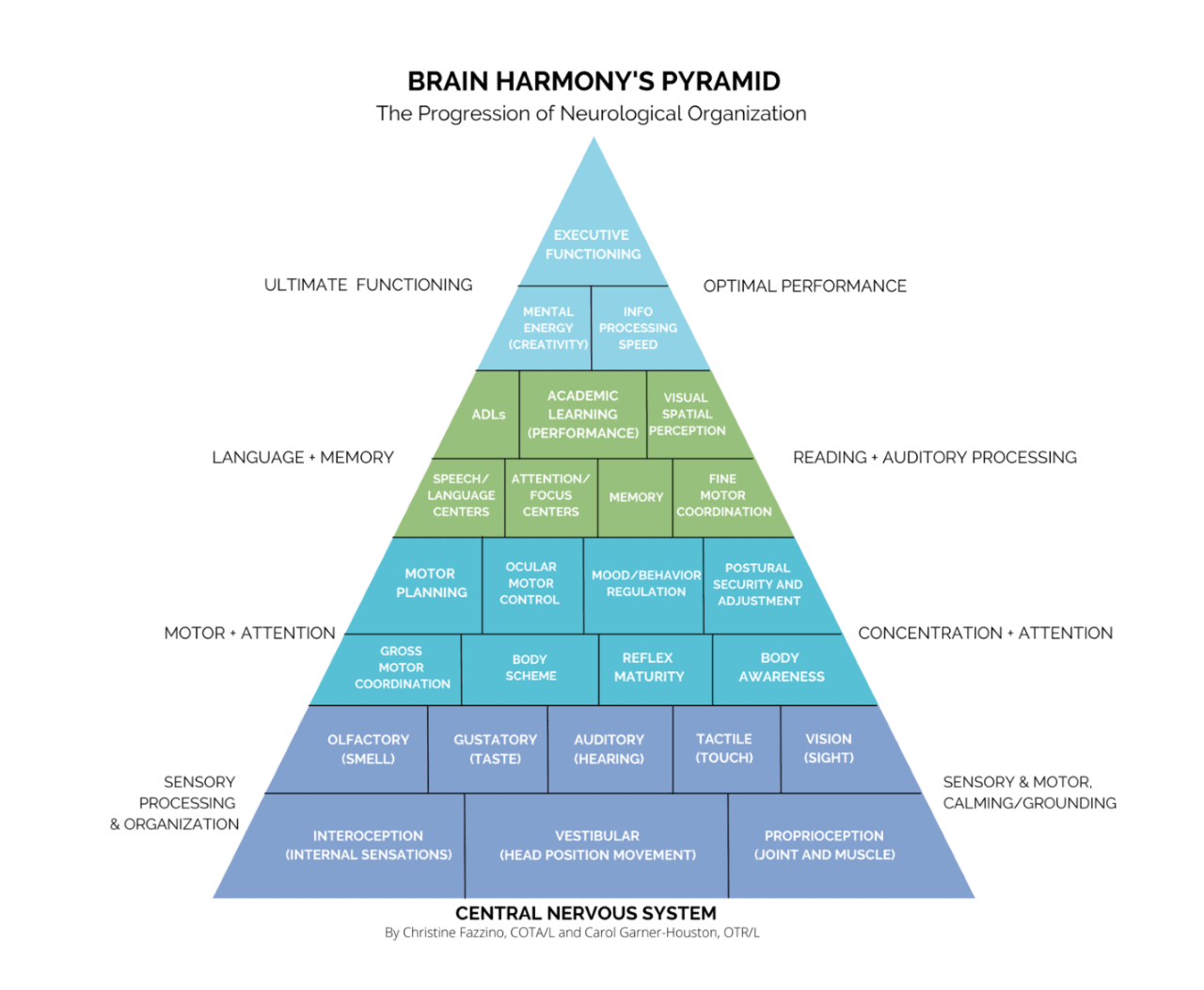We interviewed Carol Garner-Houston about the use of Brain Harmony’s occupational therapy and neuroplasticity tools for neurological disorganization. Watch the replay below!
What Is Brain Harmony?
Brain Harmony is a home program supporting children and adults worldwide to rewire their brains and treat the underlying central nervous system disorganization at the root of:
- Hyperlexia
- Anxiety
- PTSD
- Strokes
- Post-concussive syndrome
- Neurological symptoms
Brain Harmony’s repeated, simultaneous, multisensory approach builds neurological pathways and increases synaptic activity at any age. It does this with a proprietary 5-Step Plan of Care that is tailored to each person. The plan includes:
- Vagal regulation, which gets the body out of fight or flight and calms down the nervous system
- Neurological organization using a combination of tools to improve brain function
- Reflex integration using manual intervention to integrate retained primitive reflexes
- Therapeutic activities that incorporate balance, strength, and range of motion, to further organize the brain and improve functional activity
- Self-care skills that break complex tasks into simple, digestible steps and work on frustration tolerance, coping skills, and more
In This Webinar
In this webinar, Carol helped us answer the following questions:
- What is Brain Harmony?
- Which kinds of neurological disorders is Brain Harmony best used for? Does this include seizures?
- Why is vagal-nerve regulation the first step in the program?
- Which kinds of tools are used for neurological reorganization?
- Are retained reflexes common in most people with neurological disorders? Which reflexes?
- What are some of the therapeutic activities that Brain Harmony uses to organize the brain?
- What is the age range of people that can be helped by Brain Harmony?
- How is Brain Harmony different than Brain Balance?
- Does Brain Harmony negate the need for therapies such as vision therapy or auditory therapy?
- Is this program 100% home-based? Can it be used by anyone, anywhere in the world?
Please note that you will be asked to provide your email address at the 30-minute mark to continue viewing the replay.
Resources Mentioned in This Webinar

- Steven Porges’ Safe and Sound Protocol (SSP)
- Integrated Listening System (ILS)
- ILs research and supporting data
- Brain Harmony research and case studies
- Reflex integration
- Alpha-Stim®
- Reflexes, Learning And Behavior: A Window into the Child’s Mind : A Non-Invasive Approach to Solving Learning & Behavior Problems by Sally Goddard
- The Symphony of Reflexes: Interventions for Human Development, Autism, ADHD, CP, and Other Neurological Disorders by Bonnie Brandes
- The Brain That Changes Itself: Stories of Personal Triumph from the Frontiers of Brain Science by Norman Doidge MD
- Quantum Reflex Integration with Bonnie Brandes webinar replay
- Brain Harmony success stories by condition
About Carol Garner-Houston
Carol Garner-Houston, a neurodevelopmental specialist and licensed occupational therapist with over 25 years experience, is the Founder and Chief Medical Officer of Brain Harmony.
With over two decades of experience, Mrs. Carol Garner-Houston’s expertise lies in pediatric and adult neurological development, where she has gained widespread recognition from both colleagues and patients.
In order to fulfill her career aspirations, she left her home state of Louisiana and attended Virginia Commonwealth University where she studied for her Bachelor of Science in Occupational Therapy, graduating in 1996.

She was instantly drawn to the art of occupational therapy that customizes intervention to find a patient’s unique purpose, regardless of physical or mental circumstances.
Throughout her career, Mrs. Garner-Houston has enjoyed many successes including Health Systems Innovations Award serving vulnerable populations in mental health from the National Association of Public Hospitals and Health Systems while working at Charity Hospital in New Orleans.
In 2020 she was awarded the NBCOT Impact Award for her exceptional professional commitment through dedication, hard work, and outstanding OT skills to improve their clients’ life satisfaction.
You can learn more about Brain Harmony at their website https://www.brainharmony.com/
Disclaimer
This webinar is not a substitute for medical advice, treatment, diagnosis, or consultation with a medical professional. It is intended for general informational purposes only and should not be relied on to make determinations related to treatment of a medical condition. Epidemic Answers has not verified and does not guaranty the accuracy of the information provided in this webinar.
Still Looking for Answers?
Visit the Epidemic Answers Practitioner Directory to find a practitioner near you.
Join us inside our online membership community for parents, Healing Together, where you’ll find even more healing resources, expert guidance, and a community to support you every step of your child’s healing journey.
Sources & References
Amos, P. Rhythm and timing in autism: learning to dance. Front Integr Neurosci. 2013 Apr 19;7:27.
Barnhill, E. Neural connectivity, music, and movement: a response to Pat Amos. Front Integr Neurosci. 2013 Apr 24;7:29.
Bartscherer, et al. Interactive metronome training for a 9-year-old boy with attention and motor coordination difficulties. Physiother Theory Pract. Oct-Dec 2005;21(4):257-69.
Blondis, T.A. Motor disorders and attention-deficit/hyperactivity disorder. Pediatr Clin North Am. 1999 Oct;46(5):899-913, vi-vii.
Cho, H., et al. Effects of Action Observation Training with Auditory Stimulation on Static and Dynamic Balance in Chronic Stroke Patients. J Stroke Cerebrovasc Dis. 2020 May;29(5):104775.
Cosper, S.M., et al. Interactive Metronome training in children with attention deficit and developmental coordination disorders. Int J Rehabil Res. 2009 Dec;32(4):331-6.
Attention deficit hyperactivity disorder and developmental coordination disorder: Two separate disorders or do they share a common etiology. Behav Brain Res. 2015 Oct 1;292:484-92.
Attention Deficit Hyperactivity Disorder and Motor Impairment. Percept Mot Skills. 2017 Apr;124(2):425-440.
Grigg, T.M., et al. Retained primitive reflexes: Perceptions of parents who have used Rhythmic Movement Training with their children. J Child Health Care. 2018 Sep;22(3):406-418.
Grzywniak, C. Integration exercise programme for children with learning difficulties who have preserved vestigial primitive reflexes. Acta Neuropsychologica. 2017;15(3).
Hardy, M.W., et al. Rhythm, movement, and autism: using rhythmic rehabilitation research as a model for autism. Front Integr Neurosci. 2013 Mar 28;7:19.
Herbert, J., et al. Crawling is associated with more flexible memory retrieval by 9-month-old infants. Dev Sci. 2007 Mar;10(2):183-9.
Hong, H.J., et al. Effect of Rhythmic Movement Program to Improve Walking Ability for Elderly Patients with Stroke. Indian Journal of Science and Technology. 2016 Jul;9(26).
Iverson, J.M. Developing language in a developing body: the relationship between motor development and language development. J Child Lang. 2010 Mar;37(2):229-61.
Jordan-Black, J. The effects of the Primary Movement programme on the academic performance of children attending ordinary primary school. Journal of Research in Special Educational Needs. 2005 Nov;5(3):101 – 111.
Kadivar, Z., et al. Effect of step training and rhythmic auditory stimulation on functional performance in Parkinson patients. Neurorehabil Neural Repair. 2011 Sep;25(7):626-35.
A preliminary study of motor problems in children with attention-deficit/hyperactivity disorder. Percept Mot Skills. 2003 Dec;97(3 Pt 2):1267-80.
Koomar, J., et al. Theoretical and clinical perspectives on the Interactive Metronome: a view from occupational therapy practice. Am J Occup Ther. Mar-Apr 2001;55(2):163-6.
Ladányi, K. et al. Is atypical rhythm a risk factor for developmental speech and language disorders? Wiley Interdiscip Rev Cogn Sci. 2020 Sep;11(5):e1528.
Lakatos, P., et al. A New Unifying Account of the Roles of Neuronal Entrainment. Curr Biol. 2019 Sep 23;29(18):R890-R905.
McLeod, K.R., et al. Functional connectivity of neural motor networks is disrupted in children with developmental coordination disorder and attention-deficit/hyperactivity disorder. Neuroimage Clin. 2014 Mar 26;4:566-75.
McWhirter, K., et al. The association between learning disorders, motor function, and primitive reflexes in pre-school children: A systematic review. J Child Health Care. 2022 Jul 13;13674935221114187.
Melillo, R., et al. Persistent Childhood Primitive Reflex Reduction Effects on Cognitive, Sensorimotor, and Academic Performance in ADHD. Front Public Health. 2020 Nov 17;8:431835.
Piek, J.P., et al. Motor coordination and kinaesthesis in boys with attention deficit-hyperactivity disorder. Dev Med Child Neurol. 1999 Mar;41(3):159-65.
Shaffer, R.J., et al. Effect of interactive metronome training on children with ADHD. Am J Occup Ther. Mar-Apr 2001;55(2):155-62.
Slater, J.L., et al. Timing Deficits in ADHD: Insights From the Neuroscience of Musical Rhythm. Front Comput Neurosci. 2018 Jul 6;12:51.
Smith, A., et al. Evidence for a pure time perception deficit in children with ADHD. J Child Psychol Psychiatry. 2002 May;43(4):529-42.
Sonuga-Barke, E., et al. Beyond the dual pathway model: evidence for the dissociation of timing, inhibitory, and delay-related impairments in attention-deficit/hyperactivity disorder. J Am Acad Child Adolesc Psychiatry. 2010 Apr;49(4):345-55.
Suh, J.H., et al. Effect of rhythmic auditory stimulation on gait and balance in hemiplegic stroke patients. NeuroRehabilitation. 2014;34(1):193-9.
Teicher, M.H. Final White Paper: Effects of Brain Balance Exercisesand Interactive Metronome on Children with Attention Deficit Hyperactivity Disorderare Similar to the Effects of Stimulant Medication. Harvard Medical School, Department of Psychiatry. 2020.
Toplak, M.E., et al. Time perception: modality and duration effects in attention-deficit/hyperactivity disorder (ADHD). J Abnorm Child Psychol. 2005 Oct;33(5):639-54.
Van Hirtum, T., et al. Is atypical rhythm a riskfactor for developmental speech and language disorders? J Assoc Res Otolaryngol. 2021 Jul;22(4):465-480.
Winkler, I., et al. Newborn infants detect the beat in music. Proc Natl Acad Sci U S A. 2009 Feb 17;106(7):2468-71.
Yang, B., et al. Time perception deficit in children with ADHD. Brain Res. 2007 Sep 19;1170:90-6.
Zaigham, M., et al. Prelabour caesarean section and neurodevelopmental outcome at 4 and 12 months of age: an observational study. BMC Pregnancy and Childbirth. 2020 (20)564.
Zentner, M., et al. Rhythmic engagement with music in infancy. Proc Natl Acad Sci U S A. 2010 Mar 30;107(13):5768-73.
Resources
Books
Blomberg MD, Harald and Dempsey, Moira. Movements That Heal, Rhythmic Movement Training and Primitive Reflex Integration. Independenly published, 2011.
Brandes, Bonnie. The Symphony of Reflexes: Interventions for Human Development, Autism, ADHD, CP, and Other Neurological Disorders. CreateSpace Independent Publishing Platform, 2016.
Doidge, Norman MD. The Brain That Changes Itself: Stories of Personal Triumph from the Frontiers of Brain Science. Penguin Life, 2007.
Goddard Blythe, Sally. The Well Balanced Child: Movement and Early Learning. Hawthorn Press, 2005.
Goddard, Sally. Reflexes, Learning and Behavior, A Window Into the Child’s Mind. Fern Ridge Press, 2005.
Melillo, Robert. Disconnected Kids: The Groundbreaking Brain Balance Program for Children with Autism, ADHD, Dyslexia, and Other Neurological Disorders. Penguin Group, 2015.
Melillo, Robert. Reconnected Kids: Help Your Child Achieve Physical, Mental, and Emotional Balance. Penguin Group, 2015.
Websites
Balance Brain Achievement Centers
Brain Harmony research and case studies
Brain Harmony success stories by condition
Institute for Neuro-Physiological Psychology
My Child Will Thrive: Primitive Reflexes Cheat Sheet
Quantum Reflex Integration with Bonnie Brandes webinar replay



